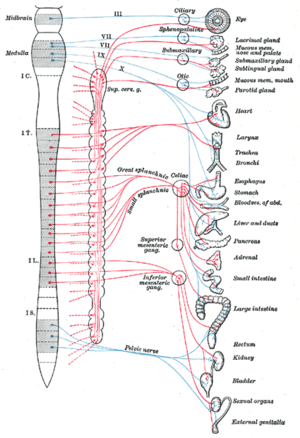Parasympathetic ganglion
Parasympathetic ganglia are the autonomic ganglia of the parasympathetic nervous system. Most are small terminal ganglia or intramural ganglia, so named because they lie near or within (respectively) the organs they innervate. The exceptions are the four paired parasympathetic ganglia of the head and neck.
| Parasympathetic ganglion | |
|---|---|
 Autonomic nervous system innervation, showing the sympathetic and parasympathetic (craniosacral) systems, in red and blue, respectively | |
| Details | |
| Identifiers | |
| Latin | ganglion parasympathicum |
| MeSH | D005726 |
| TA | A14.2.00.012 |
| FMA | 5894 |
| Anatomical terminology | |
Of the head and neck
These paired ganglia supply all parasympathetic innervation to the head and neck.
Roots
Each has three roots entering the ganglion and a variable number of exiting branches.
- The motor root carries presynaptic parasympathetic nerve fibers (GVE) that terminate in the ganglion and synapse with the postsynaptic fibers that, in turn, project to target organs.
- The sympathetic root carries postsynaptic sympathetic fibers (GVE) that traverse the ganglion without synapsing.
- The sensory root carries general sensory fibers (GSA) that also do not synapse in the ganglion.
Some ganglia also carry special sensory fibers (SVA) for taste sensation.
Nerves supplying parasympathetic fibers

Parasympathetic ganglia of the head
External links
- Histology image: 04601loa – Histology Learning System at Boston University
- Autonomics of the Head and Neck - Page 4 of 14 anatomy module at med.umich.edu
- The Autonomic Nervous System from the University of Arizona
- Diagrams
- "Terminal ganglion - Auerbach's plexus - plastic section"
This article is issued from
Wikipedia.
The text is licensed under Creative
Commons - Attribution - Sharealike.
Additional terms may apply for the media files.